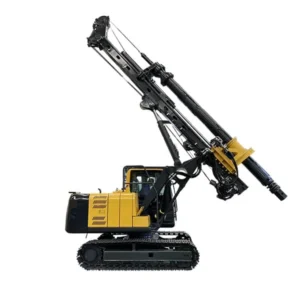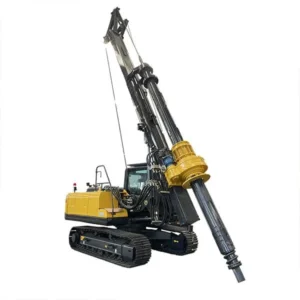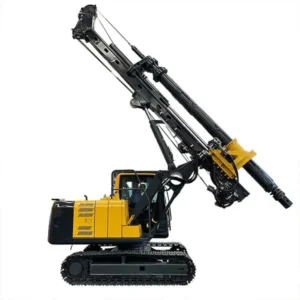Bienvenue sur mon blog !
Avant de plonger dans le contenu, j'aimerais que vous me rejoigniez sur mes plateformes de médias sociaux où je partage plus d'informations, interagis avec la communauté et publie des mises à jour. Voici comment vous pouvez me contacter :
Facebook :https://www.facebook.com/profile.php?id=100066759548969
Commençons maintenant notre voyage ensemble. J'espère que vous trouverez le contenu ici instructif, engageant et utile.
Introduction
In the world of drilling, the specifications of rotary drilling rigs are fundamental to the success of any project. These machines are the backbone of many industries, including oil and gas, geothermal energy, and mineral exploration. Understanding rotary drilling rig specifications is crucial for selecting the right equipment, optimizing performance, and ensuring safety on the job. This comprehensive guide will explore the key specifications of rotary drilling rigs, providing insights into their importance and how they impact drilling operations.
Understanding Rotary Drilling Rig Specifications

Rotary drilling rigs are complex machines with a variety of specifications that define their capabilities. These specifications determine the rig’s performance in different geological conditions, its ability to handle specific drilling depths, and its overall efficiency. Key rotary drilling rig specifications include the rig’s power, torque, pull-down capacity, drilling depth, and mast height.
Power and Torque
The power of a rotary drilling rig is one of the most critical specifications. It dictates the rig’s ability to penetrate various types of soil and rock. Power is typically measured in horsepower (HP), and the higher the horsepower, the more capable the rig is of handling tough drilling conditions. Torque, on the other hand, refers to the rotational force applied by the drilling rig. High torque is essential for drilling through dense materials, as it allows the drill bit to maintain rotation even when encountering resistance.
Pull-Down Capacity
Pull-down capacity, also known as bit weight, is the amount of downward force that can be applied to the drill bit. This specification is crucial for achieving the desired penetration rate in different soil and rock formations. A higher pull-down capacity enables the rig to drill more efficiently in harder formations, reducing the time and effort required to reach the target depth.
Drilling Depth and Mast Height
The drilling depth specification indicates the maximum depth the rig can achieve. This is a vital consideration when selecting a rotary drilling rig, as it must match the requirements of the specific project. Mast height is related to the drilling depth; it refers to the height of the rig’s mast, which supports the drill string and other components during the drilling process. A taller mast allows for the handling of longer drill pipes, facilitating deeper drilling operations.
Comparison of Specifications of Rotary Drilling Rigs of Different Sizes
| spécification | Small Rotary Drilling Rig | Medium Rotary Drilling Rig | Large Rotary Drilling Rig |
|---|---|---|---|
| Power (HP) | 150 HP | 300 HP | 500 HP |
| Torque (Nm) | 10,000 Nm | 25,000 Nm | 40,000 Nm |
| Pull-Down Capacity (lbs) | 20,000 lbs | 50,000 lbs | 80,000 lbs |
| Drilling Depth (ft) | 3,000 ft | 8,000 ft | 15,000 ft |
| Mast Height (ft) | 50 ft | 75 ft | 100 ft |
| Mobility | High (Truck-Mounted) | Moderate (Skid-Mounted) | Low (Stationary) |
| Poids | 20,000 lbs | 50,000 lbs | 100,000 lbs |
| Best Use | Shallow drilling, exploration | General drilling projects | Deep drilling, heavy-duty operations |
This table provides a comparison of the key specifications for rotary drilling rigs of different sizes, highlighting their power, torque, pull-down capacity, drilling depth, mast height, mobility, and ideal applications.
Rotary Drilling Rig Specifications in Different Applications
The specific requirements of a drilling project determine the appropriate rotary drilling rig specifications. For instance, in oil and gas exploration, the rig must have a high drilling depth and substantial power to penetrate deep underground reservoirs. In contrast, geothermal drilling might prioritize high torque to deal with hard rock formations encountered at varying depths.
Oil and Gas Exploration
In oil and gas exploration, rotary drilling rigs need to be equipped with high power and torque to efficiently drill through various geological layers, including hard rock and shale. The drilling depth is also a critical specification, as oil and gas reserves are often located several thousand feet below the surface. Additionally, the pull-down capacity must be sufficient to maintain the required penetration rate without damaging the equipment.
Geothermal Drilling
Geothermal drilling requires rigs with high torque and moderate drilling depth capabilities. The rig must be able to handle the high temperatures and pressures encountered when drilling into geothermal reservoirs. Additionally, the pull-down capacity must be optimized to ensure efficient drilling through hard rock formations, which are commonly found in geothermal fields.
Mineral Exploration
For mineral exploration, the rotary drilling rig specifications need to be tailored to the specific mineral being sought and the geological conditions of the exploration site. Power and torque are crucial for drilling through hard rock formations, while the drilling depth specification must match the expected depth of the mineral deposits. Flexibility in mast height is also beneficial, as it allows the rig to adapt to different drilling conditions and depths.
Practical Considerations When Selecting a Rotary Drilling Rig

When selecting a rotary drilling rig, it is essential to consider not only the specifications but also the practical aspects of the equipment. These include the rig’s mobility, ease of operation, and maintenance requirements. The choice of rig should align with the project’s specific needs, budget, and logistical constraints.
Mobility and Transport
The mobility of a rotary drilling rig is a crucial factor, especially for projects located in remote or difficult-to-access areas. Some rigs are designed to be highly mobile, with the ability to be easily transported and set up on site. Others may be more stationary, requiring more time and effort to move but offering greater stability and power.
Facilité d'utilisation
User-friendly controls and automated features can significantly enhance the efficiency of drilling operations. When evaluating rotary drilling rig specifications, consider the rig’s ease of operation, including the availability of advanced control systems that allow operators to monitor and adjust drilling parameters in real-time.
Entretien et assistance
Regular maintenance is vital to ensure the longevity and reliability of a rotary drilling rig. When choosing a rig, it is important to consider the availability of spare parts, the complexity of maintenance procedures, and the level of technical support provided by the manufacturer. A rig with a robust support network can minimize downtime and keep the project on schedule.
Conclusion
Understanding rotary drilling rig specifications is essential for selecting the right equipment for your project. By carefully considering key specifications such as power, torque, pull-down capacity, drilling depth, and mast height, you can ensure that the rig you choose is well-suited to the demands of your specific application. Whether you are involved in oil and gas exploration, geothermal drilling, or mineral exploration, selecting the appropriate rotary drilling rig can make a significant difference in the success of your project.
FAQ
What are the most critical rotary drilling rig specifications to consider?
The most critical rotary drilling rig specifications include power (HP), torque (Nm), pull-down capacity, drilling depth, and mast height. These factors determine the rig’s performance in various drilling conditions.
How does torque influence rotary drilling rig specifications?
Torque, measured in Newton-meters (Nm), is crucial for drilling through dense materials. Higher torque allows the drill bit to maintain rotation and effectively penetrate hard rock formations.
Why is pull-down capacity an important rotary drilling rig specification?
Pull-down capacity refers to the downward force applied to the drill bit, affecting the penetration rate. A higher pull-down capacity improves drilling efficiency, especially in tough geological conditions.
How does drilling depth affect rotary drilling rig specifications?
Drilling depth specifies the maximum depth the rig can achieve. It’s a vital specification to ensure that the rig can reach the target depth required for the project, whether for oil, gas, or mineral exploration.
What role does mast height play in rotary drilling rig specifications?
Mast height is related to the handling of drill pipes and overall drilling depth. A taller mast allows the rig to use longer drill pipes, facilitating deeper drilling operations.
How do rotary drilling rig specifications vary for different applications?
Rotary drilling rig specifications vary based on the application, such as oil and gas exploration, geothermal drilling, or mineral exploration. Each application may require different power, torque, and drilling depth specifications.
Can rotary drilling rig specifications be customized?
Yes, many manufacturers offer customization options for rotary drilling rig specifications to meet specific project requirements, including adjustments to power, torque, and drilling depth.
How does the size of the rig impact rotary drilling rig specifications?
The size of the rig directly impacts its specifications. Larger rigs typically offer higher power, torque, and drilling depth capabilities, while smaller rigs are more mobile and suitable for shallow drilling.
What safety features should be included in rotary drilling rig specifications?
Safety features in rotary drilling rig specifications may include emergency stop systems, automated controls, and robust structural components to handle the stresses of deep drilling.
How do environmental conditions affect rotary drilling rig specifications?
Environmental conditions, such as temperature, altitude, and soil type, can impact the choice of rotary drilling rig specifications. Rigs must be selected based on their ability to perform under the specific conditions of the project site.









-150x150.webp)
